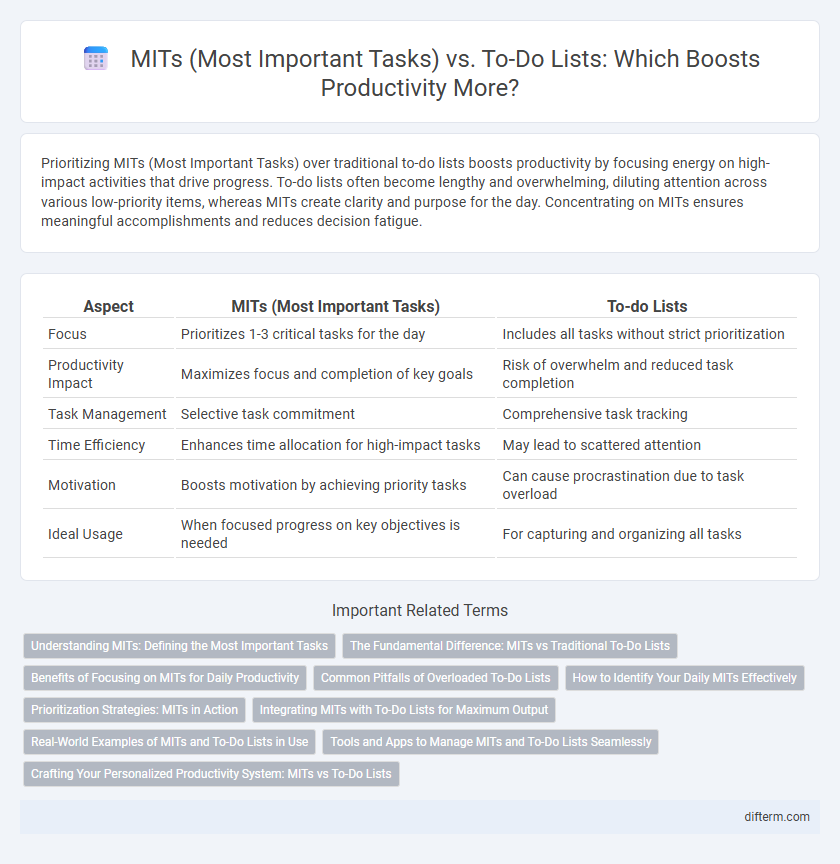Prioritizing MITs (Most Important Tasks) over traditional to-do lists boosts productivity by focusing energy on high-impact activities that drive progress. To-do lists often become lengthy and overwhelming, diluting attention across various low-priority items, whereas MITs create clarity and purpose for the day. Concentrating on MITs ensures meaningful accomplishments and reduces decision fatigue.
Table of Comparison
| Aspect | MITs (Most Important Tasks) | To-do Lists |
|---|---|---|
| Focus | Prioritizes 1-3 critical tasks for the day | Includes all tasks without strict prioritization |
| Productivity Impact | Maximizes focus and completion of key goals | Risk of overwhelm and reduced task completion |
| Task Management | Selective task commitment | Comprehensive task tracking |
| Time Efficiency | Enhances time allocation for high-impact tasks | May lead to scattered attention |
| Motivation | Boosts motivation by achieving priority tasks | Can cause procrastination due to task overload |
| Ideal Usage | When focused progress on key objectives is needed | For capturing and organizing all tasks |
Understanding MITs: Defining the Most Important Tasks
Most Important Tasks (MITs) prioritize high-impact activities that directly align with key goals, unlike traditional to-do lists that often include routine or low-priority items. Defining MITs requires evaluating tasks based on their contribution to long-term objectives and potential to drive significant progress. Emphasizing MITs enhances productivity by focusing energy and time on what truly moves projects forward.
The Fundamental Difference: MITs vs Traditional To-Do Lists
MITs (Most Important Tasks) prioritize a limited number of high-impact actions to drive meaningful progress, whereas traditional to-do lists often accumulate many low-priority or routine tasks that dilute focus. MITs emphasize quality over quantity by identifying and scheduling 1-3 critical tasks daily that align with key goals, ensuring consistent forward momentum. Unlike expansive to-do lists, MITs avoid task overload, reducing decision fatigue and enhancing productivity through intentional task selection.
Benefits of Focusing on MITs for Daily Productivity
Focusing on MITs (Most Important Tasks) enhances daily productivity by directing attention to high-impact activities that drive significant progress, unlike traditional to-do lists that often scatter focus across numerous minor tasks. Prioritizing MITs reduces decision fatigue and improves time allocation, ensuring critical goals are met efficiently. This approach streamlines workflow, increases task completion rates, and fosters purposeful momentum throughout the day.
Common Pitfalls of Overloaded To-Do Lists
Overloaded to-do lists often lead to decreased productivity by creating a false sense of accomplishment without prioritizing critical tasks. This common pitfall causes decision fatigue and task-switching, which impairs focus and reduces the completion rate of Most Important Tasks (MITs). Streamlining daily goals to a few MITs ensures higher efficiency and aligns efforts with key outcomes.
How to Identify Your Daily MITs Effectively
Identifying your daily MITs effectively involves prioritizing tasks based on their impact on your key goals rather than simply ticking off to-do list items. Use methods like the Eisenhower Matrix or the Ivy Lee Method to evaluate urgency and importance, ensuring your MITs align with long-term objectives. Regularly review and adjust your MITs each morning to maintain focus on the highest-value activities that drive productivity and goal achievement.
Prioritization Strategies: MITs in Action
MITs prioritize high-impact activities by focusing on three crucial tasks daily, ensuring meaningful progress toward goals instead of overwhelming multitasking common in traditional to-do lists. This strategy enhances productivity by reducing decision fatigue and promoting deep work, aligning efforts with core objectives. Prioritization through MITs sharpens focus and resource allocation, leading to measurable performance improvements compared to generic task management.
Integrating MITs with To-Do Lists for Maximum Output
Integrating MITs (Most Important Tasks) with traditional to-do lists boosts productivity by prioritizing high-impact activities within a comprehensive task framework, ensuring focused progress on critical goals. Organizing daily workflows by highlighting MITs at the top of to-do lists streamlines task management and reduces time spent on low-priority items. Leveraging digital tools like task managers or apps that allow tagging and filtering of MITs enhances clarity and drives maximum output through efficient task prioritization.
Real-World Examples of MITs and To-Do Lists in Use
MITs prioritize key daily objectives that drive significant progress, such as Elon Musk's focused task list that narrows projects to critical outcomes, boosting efficiency and decision-making. In contrast, traditional to-do lists often contain extensive, less impactful tasks, as seen in typical office settings where employees track numerous minor activities that dilute focus. Real-world implementation of MITs results in higher productivity by concentrating effort on transformative actions, whereas conventional to-do lists risk overwhelming users with quantity over quality.
Tools and Apps to Manage MITs and To-Do Lists Seamlessly
Effective productivity tools like Todoist, Microsoft To Do, and Asana enable users to prioritize MITs by allowing task tagging, due dates, and priority levels, ensuring focus on high-impact activities. Apps such as Trello and Notion integrate customizable boards and databases, facilitating seamless management of both MITs and extensive to-do lists with clear visualization and progress tracking. Incorporating features like reminders, collaboration, and AI-based suggestions, these tools streamline task organization, reduce cognitive load, and enhance task completion rates.
Crafting Your Personalized Productivity System: MITs vs To-Do Lists
Crafting your personalized productivity system involves prioritizing Most Important Tasks (MITs) over traditional to-do lists to enhance focus and efficiency. MITs zero in on high-impact activities, reducing overwhelm and decision fatigue commonly associated with extensive to-do lists. Implementing a system centered on MITs encourages deliberate daily goal-setting, driving meaningful progress and sustained productivity.
MITs (Most Important Tasks) vs To-do lists Infographic

 difterm.com
difterm.com